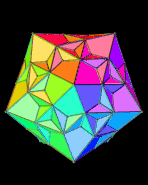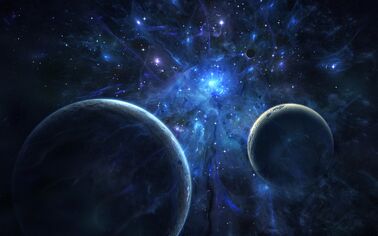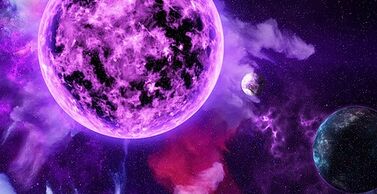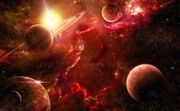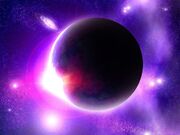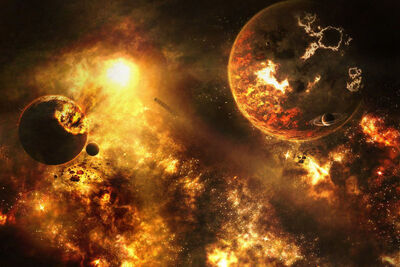This page is part of Structures Throughout Transinfinite Spaces
Quick Note: "Probabilistic" had to actually be "Probabilistical". So please consider this page as Probabilistical The Box Supercluster.
And as I mentioned in Probabilistical The Box supercluster page, this page should not be used as source of facts.
⌬ About probabilistical The Box Hypercluster[]
Probabilistical The Box Hypercluster is upper structure of Probabilistical The Box Supercluster (which looks approximately same as it from inside perspective). Countless supercluster structures are spread and connected together by little tiny infinite 1D strings (thus invisible), and connection constantly crumbles and reconnects by unknown interactions.
⌬ Some Facts About Hypercluster[]
Probabilistical The Box Hypercluster is an ordinal transinfinite structure enveloped by every possible dimensions and kinds of alternative dodecahedrons and above regular polyhedron. Why dodecahedton especially? It is because I like it ehhh I mean the dodecahedron is most liked because it is much more stable for energy holding than other polyhedrons.
Like supercluster, hypercluster has galaxies, cores, things and so on. The only difference is that every boxes are replaced with different levels of superclusters. Anyways, hypercluster is weird place :/
Some weird trait is that inside and outside view of hypercluster is not the same. The Particle, which envelops few unique hyperclusters, has 5% of space taken up by hypercluster even though it is transinfinitely larger than hypercluster.
Reason for varying size of hypercluster is... it's not actually hypercluster's fault, it is The Particle's fault. Inner void between The Particle and Hypercluster is much, much smaller than what it actually is. Further explanations in those pages!
However from inside perspective, hypercluster is still transinfinitely smaller than The Particle. What is weird is that as soon as something escapes hypercluster, its perspective immediately decides: "5% of The Particle's inner space is taken up by hypercluster."
⌬ Size, temperature, and things like that[]
All "things like that" are transinfinite inside hypercluster, unlike Probabilistical The Box Supercluster which had finite "things like that".
Temperatures are quite hot here at ordinal infinities or degrees. And it is really fat at transinfinite ordinal absolute infinity. And you know what, its outermost polyhedron layer is transinfinitely sharp. Even though it is only energy flowing around in ordered pattern, don't touch it. It won't only make your finger bleed, it will also shatter you into complete energy.
⌬ Larger Spacetime Web[]
In hypercluster, there is spacetime web that acts just like inside-supercluster spacetime web. It is critical for flow of dimensional gas, and is important for everything others to work.
⌬Things Making Up Hypercluster[]
Like supercluster, Probabilistical The Box Hypercluster is made of countless things. Only its composition is quite large, some more than biggest infinite ordinal: the Ω ordinal.
⌬Superclusters[]
Superclusters are incredibly complicated hyperdimensional polyhedron shape that contains ordinal absolute infinite amount of objects inside it ("ordinal amount" is literally impossible, but one of most important original trait of these weird things is "containing everything possible & impossible"). The superclusters are main ingredient of hyperclusters, with its inside objects. Objects that can exist inside supercluster also exists in hypercluster space. A lot, A LOT OF THEM.
⌬Level 1 to 5 Superclusters[]
Left is 3D dimensional visualized polyhedron of standard supercluster.
These are the biggest and most massive supercluster. They replicate through some sort of "truncation". All corners of supercluster polyhedron occasionally becomes truncated, and fragments from that "truncation" yeets around original supercluster and forms a new one. With each replication, baby supercluster becomes tinier than its mama mother supercluster. Pattern is like this:
one replication = 50% mother supercluster size
two replication = 25% mother supercluster size
three replication = 12.5% mother supercluster size
And the chart goes on forever.
- Level 1 superclusters: They are located very close to hypercluster core. Replication is extremely frequent, and first level superclusters constantly experiences truncation. Inner space of these superclusters is experiencing constant random formation and destruction of smaller superclusters.
- Level 2 superclusters: Commonly formed by remnant of level 1 supercluster's truncation. These superclusters quickly get truncated multiple times and becomes level 3 superclusters. Truncation fragment forms level 4 superclusters.
- Level 3 superclusters: These superclusters are remnant of level 2 supercluster's truncation. The level 3 superclusters don't form through truncation fragment, it forms only by decay of level 2 supercluster.
- Level 4 superclusters: Level 4 superclusters have quite slow truncation cycle. They don't replicate as much as level 1, 2, or 3 supercluster, but level 4 superclusters replicate even though it takes very long time.
- Level 5≤ superclusters: The most abundant superclusters. They rarely has ability to truncate. Mostly formed by collisions, and since even smallest fragments can evolve into its own supercluster, some superclusters are below Planck Length and contains undetectably small boxes with every possible and impossible quantum world probability.
⌬Instabilized supercluster []
The most common polyhedron of Instabilized supercluster visualized as 3D
Instabilized supercluster is apex of chaos. It contains approximately same amount of object as normal supercluster, but in this supercluster, every possibility tangles. Its whole inside is slowly taken over by gigantic void that is devouring everything. When that void touches polyhedron of Instabilized supercluster, the void instantly evaporates.
These superclusters are like floating time bombs inside hypercluster. There is no way to predict when this will E. The explosion is also dangerous. Anything from few thousand Instabilized supercluster radius will be instantly destroyed.
To make things even worse, destroyed supercluster does not just go away; their fragments form another of Instabilized supercluster. Even though 2nd generation ones are smaller, they still spread and destroy other superclusters. Chain reaction continues until "time bomb" is small enough for other supercluster to not get destroyed.⌬Fields & forces []
Box formation field, probabilistical field, and all fields, forces, particles inside the supercluster also works at outside the supercluster, meaning polyhedron forms around energetic object or event, some sort of stars form, etc. However, in hypercluster space, there are some unique fields and forces which are different from supercluster.
⌬Supercluster Formation Field (matter field)[]
Like boxes, superclusters are formed by activities of formation field. Many sub fields act together to form something that can be called "Supercluster formation field". Because supercluster is so extreme object, it requires field of existence itself to be seriously excited. Field of existence is what gives something, well, existence.
If there is something numeric, physical, or something like that pushes away existence field, existence field generates a ripple around that object. That ripple instantly (time dilation of 0) activates every other fields such as probabilistical field and some kind of weird physical and numeric fields.
Very large event can excite existence field so much (tried to use a joke here but everything from list of jokes were extra-cringe sans-style jokes), "false existence" is briefly made. That false existence is very unstable, and immediately stops existing. But if event is large enough, the false existence can overlap each other in some places. If truncation fragment of supercluster crosses this region of false to true existence conversion region, the supercluster blooms there.
Leftover false existence now collapses, leaving only several newborn superclusters. But superclusters are not stable. And that's where infinite amount of other fields act to stabilize the supercluster.
⌬Probabilistical Field (maybe)[]
Because events that happen inside individual superclusters also happen in hypercluster space, so it is very bigg clue that probabilistical field of superclusters exist and govern actions of hypercluster (since all actions except formation of boxes are acts of this field). But probabilistical field in hypercluster space is not exactly same as one that acts inside supercluster. Because temperature of hypercluster space is infinite, probabilistical field is likely broken, and replaced by very similar field with property almost same as probabilistical field but working in infinite temperature.
Similar with polyhedron, attraction, and dimensional magnetic fields. They are likely broken in such a temperature and replaced by some other field with almost same property.
- ⌬Hypercluster's polyhedron field: Forms ~Icosi [tetra/dodeca] hedron. Polyhedrons' roles are almost same as supercluster space; decreasing energy of certain object so it does not completely destroy entire hypercluster.
- ~Icositetrahedron: Appears around objects producing immense amount of energy such as stars, holes and stuff like those.
- ~Icosidodecahedron: Appears around powerful events such as explosion of Instabilized supercluster.
- ⌬Hypercluster's attraction field: Almost exactly same as supercluster's, but has two bosons.
- Boson 1: Its job is same as in-supercluster attraction bosons: it randomly travel from particle to particle, and has about 1/10 chance of connecting striked dimensional gas particle and other dimensional gas particle that it started jumping with 1D string then goes away after successfully connecting two particle.
- Boson 2: Unlike in supercluster, 1D strings don't attract two connected particle by its own; here, the second attraction boson flows on string. When it collides with dimensional gas particle on the other side of string, two particle gets little closer. another second attraction boson flows through string, and it attracts particles closer. And that's what replaces attraction.
- ⌬Hypercluster's dimensional magnetic field: It is also same as supercluster's D-magnetic force, but this field has two bosons that carry D-magnetic force.
- Special dimensional magnetic force bosons: These bosons are infinitely stronger cousin of original D-magnetic field bosons. Same particle as light, but acts between several dimensions.
- Tail bosons: Tail bosons are negative mas particles that is trapped by wave of Special dimensional magnetic force bosons. The tail boson resonates right behind the special dimensional radiation boson, and creates two wavelength different from D-radiation. This boson transfers its mass to particle that host D-radiation hit.
⌬Ultramassive Stars []
In hypercuster space, there are HUGE dimensional gas (OF COURSE made of particles that work in infinite temperature of hypercluster) nebula formed by collisions of superclusters. Nebula usually concentrates around supercluster's polyhedron, by enormous portion of spacetime web heading toward supercluster. If the weight of D-gas is large enough, rest is done by inside force of supercluster.
Little special thing about stars of hypercluster is, that they are most abundant object in the hypercluster. Mainly because the superclusters are so easily engulfed by sticking nebula, and one other reason being stars are almost completely indestructible from outside force, granting it greater lifespan than Superclusters safe from destruction.
NOTE: indescribable energy of hypercluster space melts away barriers of verses, but does not destroy anything inside it. This creates so-called "transparent verses". Their inner observers are able to observe objects inside hypercluster, unlike inside supercluster, which does not have enough energy level to melt away verse barriers.
CONTINUED NOTE: objects of hypercluster will surely be mystical and byotiful from perspective inside verses, but they will be like inaccessible background that changes actively for eternity.
⌬Type UM1 star []
UM1 star observed from transparent universe.
If supercluster is too small to hold back collapse of D-gas (more than level 5), it completely shatters away. Energy given off presses supercluster core so hard, that supercluster core contains every single drop of supercluster's mass. Enveloped in ultracomplicated hyperdimensional polyhedron, core's Hyper-D polyhedron corner generates duality core (usually the center of Box galaxy cluster) with mass few millions of times smaller than itself.
As the star gains more and more mass from tail bosons, inner polyhedron layer contracts, while outer layer expands. Outer layer slowly escapes from star, and stops expanding if it finds equilibrium between radiation pressure from the star and contraction.
Inner polyhedron layer collide with supercluster core one by one, and collapses little stability of supercluster that may have left. Supercluster core then releases infinite amount of possible superclusters it contained and connected. Explosion generates infinite energy which ignites fusion of star. Ignition is so powerful, it shatters every supercluster released and collapses supercluster core to giant black hole.
Fragments of superclusters fly through D-gas with such speed, they produce countless fusion ignition points behind and erode away, just like reversed meteor strike. However, some fragments are large enough to make it through star's all layers and to outside. Star is surrounded by fragment cloud and is superheated. Then star follows same lifecycle as most massive black hole stars, first slowly changing its spectral type to ω.
⌬Type UM2 star[]
View from transparent universe right next to type UM2 star
This is just surprisingly CHONK white hole star. When dimensional gas concentrates enough around supercluster, the collapse forms a black hole. But now, shockwave is so violent that black hole crushes too much. Actually too, too, TOO much.
Black hole seems to disappear into oblivion, but it bounces off disappearing spot and product of that is white hole. A white hole with mass greater than supercluster. Of course, it now follows same lifecycle as most massive white hole stars.
⌬Type UM3 & UM4 stars[]
Left image and right image are type UM3 and UM4 star obse... suck it you know what comes next :P
kek it is too obvious but I write it anywayz so ye UM3 stars are formed when there is some huge gas around absurdly overgrown supercluster void. Those emptinesses provide ungraspable energy by collapsing false existence produced inside them.
Blah blah blah UM3 star then follows same lifecycle as most massive void stars blah blah blah now to UM 4 stars. They contain some huge antivoids. Antivoid's juice leaks out because shockwave punches hole in antivoid's juice bottle and energy contained in antivoid spills to outside, powering the star not imagination. You surely know how this star type will live and die.
⌬Type UM5 star[]
Observed fro- nah just gonna skip it
UM5 stars are quite interesting because they are sustained by instabilized supercluster. Of course, because instabilized supercluster is very rebellious and annoying to keep as star core, UM5 stars are EXTRA CHONK than other lower UM(0<n<5) stars. Instabilized supercluster annoys and explodes to escape the star core but star say nope.
But this tug o war doesnt last long. Rebellious instabilized supercluster eventually blows away whole star while OSM1,2,3,4 star cores are constantly produced and stars run away (faster than mouse cursor when footstep is heard from upstairs while u r playing 3AM game) from UM5 star once it gets out of surface of star.
Constant mass loss expands the star more and more. At some point, star is light enough for instabilized supercluster to explode outward, and release all energy accumulated. Then star pops with explosion much more powerful than instabilized spercluster's yeet.
⌬Type UM6 star[]
You know where it is observed from :P
These stars are CHONK enough to re-consume almost all newborn stars that escaped from it. However, this is not really a good news. Small colliding stars keeps pressing on body of UM6 star, raising energy level. The energy level rises enough that instabilized supercluster shrinks and explode.
Because UM6 stars are such CHONK stars, even explosion of instabilized supercluster cannot blow away whole star. Star just expands a bit more, and don't care whether its core dies or not; it has enough energy to create new one.
After new instabilized core forms, it also shatters by increasing pressure. This cycle repeats until star loses enough material away that inner accumulated energy can pop the star. Of course, another huge and beautiful explosion its size non-comparable to other UM stars.⌬Star's remnants[]
Eventually, every stars die due to outward eruptions or whatever. Similar to supercluster's stars, hypercluster's stars leave part of it as something similar to astonomical object, or, in quite rare cases, they leave very interesting object never seen before. The formation process is little awkward compared to how black hole stuff forms from death of star.
⌬Common Remnants[]
Common Remnants are... ... ... yeah literally common stellar remnants such as various types of holes that star leaves after death. They form when no outside interference disrupts the dying star. However, the term "common remnant" includes bizarre objects that can never be seen in lower structures as universe. So, to summarize the definition, Common Remnants are star's part after its death, formed solely by star itself, without any outside influences.
Because definition is definition, common remnants are... common.
⌬Superclusters[]
Remnant of: Every stars
In space like hypercluster where (relatively) small event can create the supercluster, star's death is gold rush to supercluster formation. As soon as star is dead, supercluster formation field activates (however it's more like this. And you don't call explosion of electric circuit "activation"). But oh well, poor superclusters. They die immediately because star's explosion compressing and re-expanding supercluster.
⌬Chonkclusters
However sometiems, abnormal superclusters form from star's death. such as this thing called Chonkcluster. Chonkclusters are at least much more normal than other abnormal superclusters, because Chonkcluster is just some seriously large superclusters. MUCH more than its original size. They form when supercluster formation field gets too much energy and bursts (like this).
Of course, leaving that region busted only does bad things such as destruction of hypercluster. Field tried to patch itself, but does it too quickly. Compressed supercluster formation field can briefly hold more energy, then create some seriously chonk supercluster, the chonkclusters! They are basically invulnerable to colliding Instabilized Superclusters. It has LOTS of time to send off bunch of supercluster seeds, so commonly, space around chonkcluster is very busy.
⌬Energyclusters
the real abnormality begins here. Again, formation field breaks as hecc. It can hold very big energy for brief time. What's different in this case, is secondary explosion of star. If the star's outer layer was something that exploded first (common phenomenon. Happens because outer layer is heated beyond its energy capacity), and star core's explosion is contained by immense force, it may break through outer layer's explosion anytime.
When core explosion breaks through even before the patching is complete, superclusters (that were still being made from weird energy alignment of formation field) get flung out by force. formation field can no longer do anything about incomplete superclusters, and superclusters remain as structure purely composed of energy. Not really problematic phenomenon, but energyclusters act like instabilized superclusters. So not really good objects overall.
⌬Miniversecluster
When the impostor is sus!!1!1!11 formation field gets more energy than it gets when Energyclusters are produced, spacial laws of supercluster stops making sense and miniversecluster forms. Following properties described at miniverse page, Miniversecluster has one huge structure taking up most of its inner space. Also, Miniversecluster's size from outside perspective varies so much from Miniversecluster's size from inside perspective.
This pretty much destroys what may have left of supercluster's habitability. If Purple Hole or Dimensional Gas Star becomes that "major object" of Miniversecluster, verses basically can't exist because inside of Miniversecluster is hotter than computer running games in "games for low-end PCs" youtube video (srsly what is youtubers' "low-end" computer). All verses melt from intense heat, disintegrating into dimensional gas.
⌬Degenerate Remnant[]
Remnant of: UM2 stars ~ UM5 stars
Degenerate Remnants are little tiny spheres of weird materials left after huge blow of supernova sweeps across the core of star and compress it. Diffferent types of stars have different compression sequence, so every different types of stars (except type UM1 and UM6) leave significantly different Degenerate Remnants from other spectral types.
Oh and about type UM1 and UM6 stars not being able to produce Degenerate Remnants, UM1 stars have too low pressure upon death to even form lightest and most boring Degenerate Remnants, UM6 stars at exact opposite. Degenerate Stars go instant YEET when forming inside UM6 stars because they go aight Imma head out when they are exposed to pressure of UM6 stars which is even greater than threshold of NOKIA3310.
⌬Degenerate star / made by: UM2 stars
When UM2 stars die, their core white hole implodes. But instead of bouncing back to become a black hole, white hole (partially) explodes. White hole spits fire into all directions, trying to push away angry star trying to crush it. And as you know, if something is heated, it expands, and pressure increases. Just like that, white hole is expanding the matter around it, increasing pressure. So yeah, white hole core causes its own ultimate demise.
After white hole does dumb initial act, white hole spits more and more fire. Eventually, white hole goes away. Fusion rate of dimensional gas particles is put on rocket fueled by political conversations on twitter. But at some point, the fusion rate slows down a bit. When that happens, shockwave formed at center of star is ready to resonate upward and fling entire outer layer of star. Star dies, but tightly compressed core remains. The remaining core is degenerate star.
The degenerate star very slowly does fusion reaction from leftover light dimensional gas particles. Although it is wrote "slowly", energy produced from fusion inside insanely dense object is enough to make degenerate star glow with brightness approximately equal to UM1 type star. Which is definitely level of Cursed if you consider the Degenerate star's size (it's, like, its size is *very complicated and large function formula goes here* times smaller than UM1 type star)
⌬Blue energy ball (?) / made by: UM3 stars
This one megachonk mass of dimensional gas around supercluster's megachonk void has longest life among all stars. During the megachonk lifespan, void can sustain the star without problem. The problem(s) arise very quickly when void's size decrease. The color of light the void emits gets diverse as it produces more energy at different level, which does basically same thing as white hole!
Void is compressed until it explodes because there is no more void. But inside the explosion, high-mass (is not matching word to describe how massive UM3 stars' Degenerate Star is compared to UM2 stars') degenerate star goes aight Imma head out to be crushed into... something much hotter and active than Degenerate Stars. that "sort of" degenerate star draws close to all energy of void's explosion. Then, sort-of-Degenerate-Star radiates it slowly.
Also yes, even though there is word "slowly", the energy ball glows with huge power.
⌬Everlasting solid dimensional gas (!) / made by: UM4 stars
Unlimited (that's a lie) power of UM4 star supernova can crush some unusual thing into solid ball slowly emitting away particles, but in inverse proportion pattern, so the ball never truly disappears. That unusual thing is power source for stars, and also the one causes boom of it. Cannot exist as solid, but only able to exist as plasma. Cmon it is dimensional gas!
After a huge blow (UM4 star supernova), dimensional gases get packed close to each other. Usually this will cause packed dimensional gas to explode even more violently than UM4 star supernova. However in this case, supernova jumbles all packed particles into huge mass, that particles loose boundaries. They bond together to become something like sponge, but hotter than star powered by useless rage of people having political discussion and nearly unbreakable.
⌬Very mysterious b e a n / made by: UM5 stars
Supernova from UM5 stars leave (always) rapidly spinning mysterious ball of material. The spinning of ball is really fast, enough to stretch it sideways so much. Stretching ultimately leads the ball to become b e a n. Spinning of the b e a n accelerates as time passes (!), which is odd, since it does not get any additional energy. As its spin speed goes up, the ball becomes more and more stretched b e a n. When the b e a n goes too hype, it shatters.
Everything is fine except the fact material making up the b e a n is at between boundary of existence and nonexistence. Which means we can see it but cannot know anything about it. Wth.
⌬Property Wells[]
Remnant of: UM6 stars
"Property wells" is a fancy of saying "black holes but they absorb ridiculous things such as Amogus". It is quite interesting that stars can generate various types of holes depending on core's peak pressure at their moment of death. Property wells are pretty much the most extreme object observable after star's death discluding anomalies.
⌬Attraction holes
There are so many types of Attraction Holes, that I can't possibly list them all. Every dying UM6 type star leaves different types of attraction holes. Types of attraction holes include, very basic, black holes and white holes. The critical difference from original ones is, black holes and white holes always radiate like crazy, glowing with high-energy bosons. Among countless types of bosons emitted by basic holes forming wide range of bizarre colors, something similar to blue is most common color.
⌬Anomalies[]
As a name "Anomalies" tells, these are unique and uncommon ones. When type UM6 star is constantly influenced to weird effects (say, constant collision of superclusters increasing inner pressure) during life or experience some special phenomenons during death process, anomaly may form. Anomaly is special, and rare. While one star can rarely form multiple common remnants, one star only forms one Anomaly upon death. PERIOD.
⌬Anomaly #1: Warp gates[]
WIP!!!!!!!!!! :D
⌬Anomaly #2: Pseudo-star[]
WIP!!!!!!!!!! :D
⌬Anomaly #3: Energy container[]
WIP!!!!!!!!!! :D
⌬Anomaly #4: Miniverstar[]
WIP!!!!!!!!!! :D
⌬Anomaly #5: Destructive region[]
WIP!!!!!!!!!! :D
⌬Anomaly #6: Negative star[]
WIP!!!!!!!!!! :D
⌬Anomaly #7: Multi-type objects[]
WIP!!!!!!!!!! :D

